Comments / Questions (17)
![]() Deb wrote:
Deb wrote:
I’ve started this a couple of times but the counting doesn’t work out. If I am doing 12-18mo, that’s the fourth number - so am casting on 98 stitches. If there are 12 stitches of each sleeve and 35 stitches of pattern front and back that is 24 + 70 and that total is 94….Is this a mistake? Should I be casting on 94? I realize the first increase in the sleeves is adding 4 stitches on each sleeve but that shouldn’t affect the original number of stitches being knit upon. Please help!
25.06.2025 - 21:43DROPS Design answered:
Hi Deb, Your missing stitches are the marker-stitches (as each marker is inserted into a stitch), with 12 stitches on each sleeve between the marker-stitches and 35 stitches on the front and back pieces between the marker-stitches. Regards, Drops Team.
26.06.2025 - 06:35
![]() Johanna wrote:
Johanna wrote:
Hello, question (12/18 months) - Yoke: Round 1 I increased 4 per sleeve, in round 2 I increase 2 in each sleeve, for round 3 am I supposed to increase 4 again? and so on each odd round? or the increase 4 stitches evenly spaced is only on the first round? - the rest of the increases in the diagrams are clear, just the sleeves ones are confusing. Thanks
30.05.2025 - 22:02DROPS Design answered:
Dear Johanna, the stitches increased evenly in each sleeve are only worked once and not repeated. From the first round onwards you will only work the RAGLAN increases, 2 stitches on each sleeve every 2nd round/ on alternate rounds. So you will increase 2 stitches for each sleeve on increase rounds. Happy knitting!
01.06.2025 - 23:49
![]() Giuseppina wrote:
Giuseppina wrote:
"Ärmel: den 1. Markierer in der ersten Masche anbringen, 12 Maschen [...] Rückenteil: A.1 1 x, A.2 3-3-3-4-4 x, A.3 1 x." Ich habe zuvor 86 Maschen auf der Nadel ...habe aber am Ende dieser Anweisung noch 4 Maschen übrig....was soll ich mit denen machen? Laut Anweisung stimmt das auch so: 12M + 1xA1 (6M)+ 3x A2 (18M) +1xA3 (5M) + 12M + 1xA1 (6M)+ 3x A2 (18M) +1xA3 (5M) =82 Maschen Ich hab aber doch 86 auf der Nadel ...
03.04.2025 - 16:09DROPS Design answered:
Liebe Giuseppina, und dazu kommen die 4 Maschen mit je einem Markierer (die Markierer sind je in einer Masche eingesetzt, nicht zwischen Maschen), so haben Sie 86 Maschen. Viel Spaß beim Stricken!
04.04.2025 - 08:12
![]() Ute Rudolf wrote:
Ute Rudolf wrote:
Sie schreiben Ärmel: 1. Markierung in die erste Masche setzen, 12 Maschen glatt rechts stricken und gleichmäßig verteilt 4 Maschen zunehmen, 2. Markierung in die nächste Masche setzen. = 14 , aber Wenn ich 4 Maschen gleichmäßig verteilt zunehme sind das 12 +4 =16 , also 16 +29+16+29 =90. Sie rechnen für Größe 6/9 Ärmel 14+29 Vorderteil+14 Ärmel+29 Rückenteil =86 Maschen. Wo mache ich den Denkfehler?
29.03.2025 - 19:27DROPS Design answered:
Liebe Frau Rudolf, ja genau werden in 6/9 M sind die Maschen so verteilt: 1 M mit Mark, 12 M (Ärmel), 1 M mit Mark., 6 M A.1, 3x6 M A.2, 5 M A.3 (= 6+18+5=29 M Vorderteil), 1 M mit Mark.,12 M (=Ärmel), 1 M mit Mark., 6 M A.1, 3x6 M A.2, 5 M A.3 (= 6+18+5=29 M Rückenteil) = 1+12+1+29+1+12+1+29=86 Maschen - ich sehe doc keine 14 M, verpasse ich etwas oder misverstehe ich Ihre Frage?
31.03.2025 - 08:49
![]() El wrote:
El wrote:
Hallo, \r\nich verstehe leider nicht genau, wie die 5. Reihe von A.2 in der Passe gestrickt werden soll, wenn alle Zunahmen vollendet sind und nur noch in A.2 gestrickt wird. \r\nWie wird die \"Schwarze\" Masche gestrickt und was ist gemeint mit \" die letzte Masche des letzten Rapports von Vorderteil/Rückenteil über die erste Masche des Ärmels stricken.\"? \r\nVielen Dank im voraus
06.01.2025 - 21:15DROPS Design answered:
LIebe El, bei der 5. Reihe werden die 2 letzten Maschen A.1 zusammen mit der 1. Masche A.2 gestrickt, dann stricken Sie A.2 wie gezeigt (= 1 M re, 1 Umschlag, 1 M re, 1 Umschlag, 1 M re), dann stricken Sie die 2 letzten Maschen A.2 zusammen mit der 1. Masche vom nächsten A.2 (und dann A.3). Viel Spaß beim Stricken!
07.01.2025 - 10:06
![]() Marie Claude Jalabert wrote:
Marie Claude Jalabert wrote:
Bonjour, Lorsque on commence les augmentations pour le raglan doit on continuer à augmenter également 4 mailles pour la manche? Et si j'ai bien compris on est au 3ème rang du diagramme. Merci de votre réponse.
15.07.2024 - 16:49DROPS Design answered:
Bonjour Marie Claude, oui, on augmente pour le devant/dos et pour les manches en meme temps. Les augmentations du devant et du dos figurent dans les diagramme (on augmente alternativement 4 et 8 mailles par tour). Pour les manches vous augmentes toujours 4 mailles par tour. Bon tricot!
15.07.2024 - 17:30
![]() Inger Marie Andersen wrote:
Inger Marie Andersen wrote:
Man kan ikke få mønster til at passe på første omgang, så må op give dette mønster
29.05.2024 - 13:43
![]() Anna wrote:
Anna wrote:
Hallo, Ich stricke in der Größe 12/18. Wenn ich A1 und A3 insgesamt 3x in der Höhe gestrickt habe und die Zunahmen im Vorder-/Rückenteil fertig sind. Wie kann ich dann weiter stricken ohne dort weiter zuzunehmen. Stricke ich dann nur noch A2 weiter. Vielen dank
31.07.2023 - 20:22
![]() Abby Hubbard wrote:
Abby Hubbard wrote:
After you have worked A.1 and A.3 and need to just work the increases on the sleeves how does the pattern on the front and back continue without increases? Are you just knitting A.2?
29.04.2023 - 03:01DROPS Design answered:
Dear Mrs Hubbard, note which stitch is the first one in A.1 and the last one in A.3 on front and back piece and mark it in the diagram, you will now work only the sts on the left of this first st in A.1 and only the first sts on the right of this last st in A.3. Make sure there will always be as many yarn overs as decreases in A.1/A.3 to avoid changing the number of sts. Happy knitting!
02.05.2023 - 08:07
![]() Pernille wrote:
Pernille wrote:
Hei, jeg skal strikke denne genseren i str. 6/9, altså 86m halskant. Omgangen etter vrangborden skal strikkes slik: Erme: 12m (+4), Forstykke: A.1+A.2=12mx3= 36m + A.3 5m = 41m Erme: 12m (+4) Bakstykke: A.1+A.2=12mx3= 36m + A.3 5m = 41m Men 12+12+41+41= 106masker. Hva gjør jeg feil? Jeg har jo bare 86 masker
22.02.2023 - 19:58DROPS Design answered:
Erme: sett 1.merke i første maske, strikk 12 masker glattstrikk og øk 4 masker jevnt fordelt, sett 2.merke i neste maske. = 14 Forstykke: A.1 =6, A.2=6 strikkes 3 ganger, A.3=5 = 29m. Erme: sett 1.merke i første maske, strikk 12 masker glattstrikk og øk 4 masker jevnt fordelt, sett 2.merke i neste maske. = 14 masker Bakstykke: A.1, A.2 strikkes 3 ganger, A.3= 29 masker. 14+29+14+29=86 masker + de masker du tager ud :)
24.02.2023 - 15:41
Cotswolds Sweater#cotswoldssweater |
||||||||||||||||||||||
 |
 |
|||||||||||||||||||||
Knitted sweater for baby in DROPS Flora. The piece is worked top down, with raglan and lace pattern. Sizes 0 – 2 years.
DROPS Baby 43-1 |
||||||||||||||||||||||
|
------------------------------------------------------- EXPLANATIONS FOR THE PATTERN: ------------------------------------------------------- PATTERN: See diagrams A.1, A.2 and A.3. RAGLAN: On the front and back pieces the increases are included in the diagram. Increase as follows on the sleeves: Increase 1 stitch after markers 1 and 3. Knit the marker-stitch, make 1 yarn over. Increase 1 stitch before markers 2 and 4. Work as far as the marker-stitch and make 1 yarn over, knit the marker-stitch. On the next round work the yarn overs twisted to avoid holes! Repeat this increase every 2nd round a total of 10-12-14-16-17 times DECREASE TIP (for sleeves): Decrease 1 stitch on either side of the marker as follows: Work until there are 3 stitches left before the marker, knit 2 together, knit 2 (marker sits between these 2 stitches), slip 1 stitch as if to knit, knit 1 and pass the slipped stitch over the knitted stitch. ------------------------------------------------------- START THE PIECE HERE: ------------------------------------------------------- SWEATER – SHORT OVERVIEW OF THE PIECE: The neck and yoke are worked in the round with double pointed needles or short circular needle, top down. The yoke is divided for the body and sleeves and the body is continued in the round with circular needle. The sleeves are worked in the round with double pointed needles. NECK: Cast on 86-86-86-98-98 stitches with double pointed needles or short circular needle size 2.5 MM = US 1.5 and DROPS Flora. Knit 1 round, then work rib (knit 1 purl 1) for 2 cm = ¾". Change to circular needle size 3 MM = US 2.5. YOKE: On the next round insert 4 markers as follows: Sleeve: Insert marker 1 in the first stitch, knit 12 and increase 4 stitches evenly spaced, insert marker 2 in the next stitch. Front piece: Work A.1, A.2 3-3-3-4-4 times, A.3. Sleeve: Insert marker 3 in the next stitch, knit 12 and increase 4 stitches evenly spaced, insert marker 4 in the next stitch. Back piece: Work A.1, A.2 3-3-3-4-4 times, A.3. Continue this pattern and increase to RAGLAN – read description above. REMEMBER THE KNITTING GAUGE! When A.1 to A.3 have been completed in height, work the next round as follows: Knit and increase over the sleeve as before as far as marker 2, work A.1, then A.2 5-5-5-6-6 times, A.3, knit and increase over the sleeve as before as far as marker 4, work A.1, then A.2 5-5-5-6-6 times, A.3. Repeat this pattern in height. Each time A.1 and A.3 are repeated in height, there is room for 2 more repeats of A.2 on the front and back pieces. When A.1 and A.3 have been worked 2-2-3-3-3 times in height, the increases are finished on the front and back pieces; continue increasing only on the sleeves as explained above. Continue the pattern on the front and back pieces, but without further increases. When all the increases are finished there are 182-190-222-242-246 stitches. Continue with pattern as follows: Start on the 2nd stitch on the round (the new beginning of the round), knit 37-41-45-49-51, work A.2 9-9-11-12-12 times, knit 37-41-45-49-51, work A.2 9-9-11-12-12 times (the last stitch in A.2 is the first stitch on the round). When you work round 5 in A.2, knit the first stitch in the first repeat on the front/back piece, the last stitch in the last repeat on the front/back piece is worked over the first stitch on the sleeve. When the piece measures 12-13-14-15-16 cm = 4¾"-5⅛"-5½"-6"-6¼" from the cast-on edge, divide for the body and sleeves as follows: Place the first 37-41-45-49-51 stitches on a thread for the sleeve, cast on 6 stitches under the sleeve, work 54-54-66-72-72 stitches as before, place the next 37-41-45-49-51 stitches on a thread for the sleeve, cast on 6 stitches under the sleeve, work the last 54-54-66-72-72 stitches. BODY: = 120-120-144-156-156 stitches. Continue in the round with A.2 over all stitches for a further 9-12-13-15-17 cm = 3½"-4¾"-5⅛"-6"-6¾". Increase 18-18-22-24-24 stitches evenly spaced on the next round = 138-138-166-180-180 stitches. Change to circular needle size 2.5 MM = US 1.5 and work rib (knit 1, purl 1) for 3 cm = 1⅛". Bind off. The sweater measures approx. 24-28-30-33-36 cm = 9½"-11"-11¾"-13"-14¼" from the shoulder down. SLEEVES: Place the 37-41-45-49-51 stitches from the thread on the one side of the piece on double pointed needles size 3 MM = US 2.5 and knit up 1 stitch in each of the 6 stitches cast on under the sleeve = 43-47-51-55-57 stitches. Insert a marker thread in the middle of the new stitches under the sleeve. Start at the marker and work stockinette stitch in the round for 1 cm = ⅜". Now decrease 2 stitches under the sleeve – read DECREASE TIP. Decrease like this every 2½-2-2-2-2½ cm = 1"-¾"-¾"-¾"-1" a total of 3-5-6-7-8 times = 37-37-39-41-41 stitches. When the sleeve measures 10-12-15-16-22 cm = 4"-4¾"-6"-6¼"-8¾" from the division increase 5 stitches evenly spaced = 42-42-44-46-46 stitches. Change to double pointed needles size 2.5 MM = US 1.5 and work rib (knit 1, purl 1) for 3 cm = 1⅛". Bind off with knit over knit and purl over purl. The sleeve measures approx. 13-15-18-19-25 cm = 5⅛"-6"-7"-7½"-9¾" from the division. Work the other sleeve in the same way. |
||||||||||||||||||||||
Diagram explanations |
||||||||||||||||||||||
|
||||||||||||||||||||||

|
||||||||||||||||||||||
Have you finished this pattern?Tag your pictures with #dropspattern #cotswoldssweater or submit them to the #dropsfan gallery. Do you need help with this pattern?You'll find 28 tutorial videos, a Comments/Questions area and more by visiting the pattern on garnstudio.com. © 1982-2025 DROPS Design A/S. We reserve all rights. This document, including all its sub-sections, has copyrights. Read more about what you can do with our patterns at the bottom of each pattern on our site. |
||||||||||||||||||||||









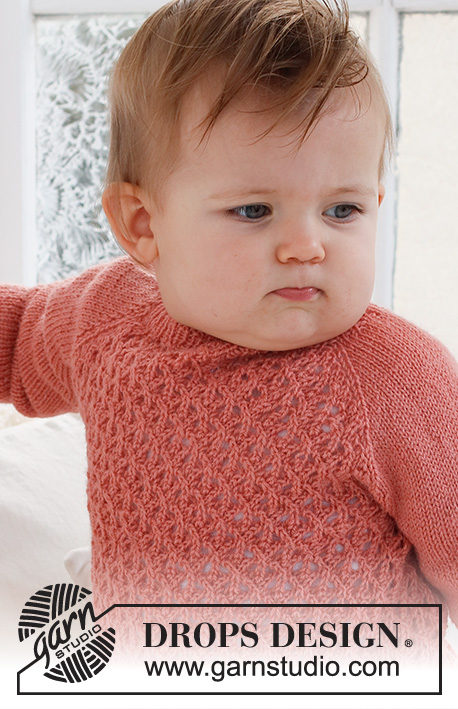



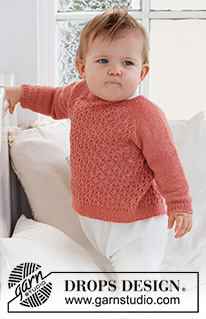
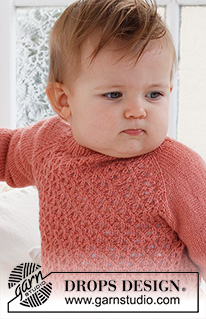







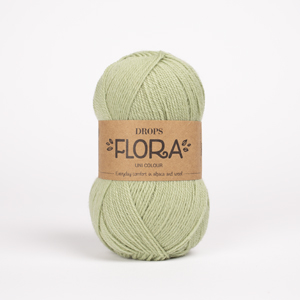
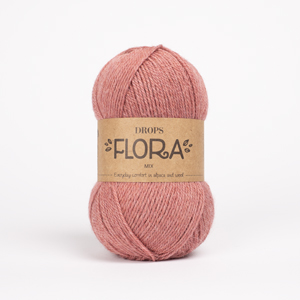


























































Post a comment to pattern DROPS Baby 43-1
We would love to hear what you have to say about this pattern!
If you want to leave a question, please make sure you select the correct category in the form below, to speed up the answering process. Required fields are marked *.